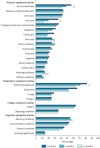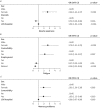Symptoms persisting after hospitalisation for COVID-19: 12 months interim results of the CO-FLOW study
- PMID: 36284829
- PMCID: PMC9421428
- DOI: 10.1183/23120541.00355-2022
Symptoms persisting after hospitalisation for COVID-19: 12 months interim results of the CO-FLOW study
Abstract
Introduction: A large proportion of patients experience a wide range of sequelae after acute COVID-19, especially after severe illness. The long-term health sequelae need to be assessed. Our objective was to longitudinally assess persistence of symptoms and clusters of symptoms up to 12 months after hospitalisation for COVID-19 and to assess determinants of the main persistent symptoms.
Methods: In this multicenter prospective cohort study patients with COVID-19 are followed up for 2 years with measurements at 3, 6, 12 and 24 months after hospital discharge. Here, we present interim results regarding persistent symptoms up to 12 months.
Results: We included 492 patients; mean±sd age was 60.2±10.7 years, 335 (68.1%) were males, median length of hospital stay was 11 (6.0-27.0) days. At 3 months after discharge 97.0% of the patients had at least one persisting symptom, this declined to 95.5% and 92.0% at 6 and 12 months, respectively (p=0.010). Muscle weakness, exertional dyspnoea, fatigue, and memory and concentration problems were the most prevalent symptoms with rates over 50% during follow-up. Over time, muscle weakness, hair loss and exertional dyspnoea decreased significantly (p<0.001), while other symptoms such as fatigue, concentration and memory problems, anosmia and ageusia persisted. Symptoms from the physical and respiratory cluster declined significantly over time, in contrast to the fatigue and cognitive symptom clusters.
Conclusion: The majority of patients experienced COVID-19 sequelae up to 12 months after severe infection. Whereas physical and respiratory symptoms showed slow gradual decline, fatigue and cognitive symptoms did not evidently resolve over time.
Copyright ©The authors 2022.
Conflict of interest statement
Conflict of interest: L.M. Bek, J.C. Berentschot and M.H. Heijenbrok-Kal have received support for the present manuscript from ZonMw COVID-19 program, Rijndam Rehabilitation and Laurens. M.E. van Genderen has received a research grant from stichting Theia and stichting SGS, outside the submitted work. R.J.G. van den Berg-Emons has received a grant from ZonMw (Dutch organisation for health research) outside the submitted work. M.E. Hellemons has received a grant from ZonMw outside the submitted work and is an associate editor of this journal. The remaining authors have nothing to disclose.
Figures




References
-
- WHO . A clinical case definition of post COVID-19 condition by a Delphi consensus. www.who.int/publications/i/item/WHO-2019-nCoV-Post_COVID-19_condition-Cl... - PMC - PubMed
LinkOut - more resources
Full Text Sources
